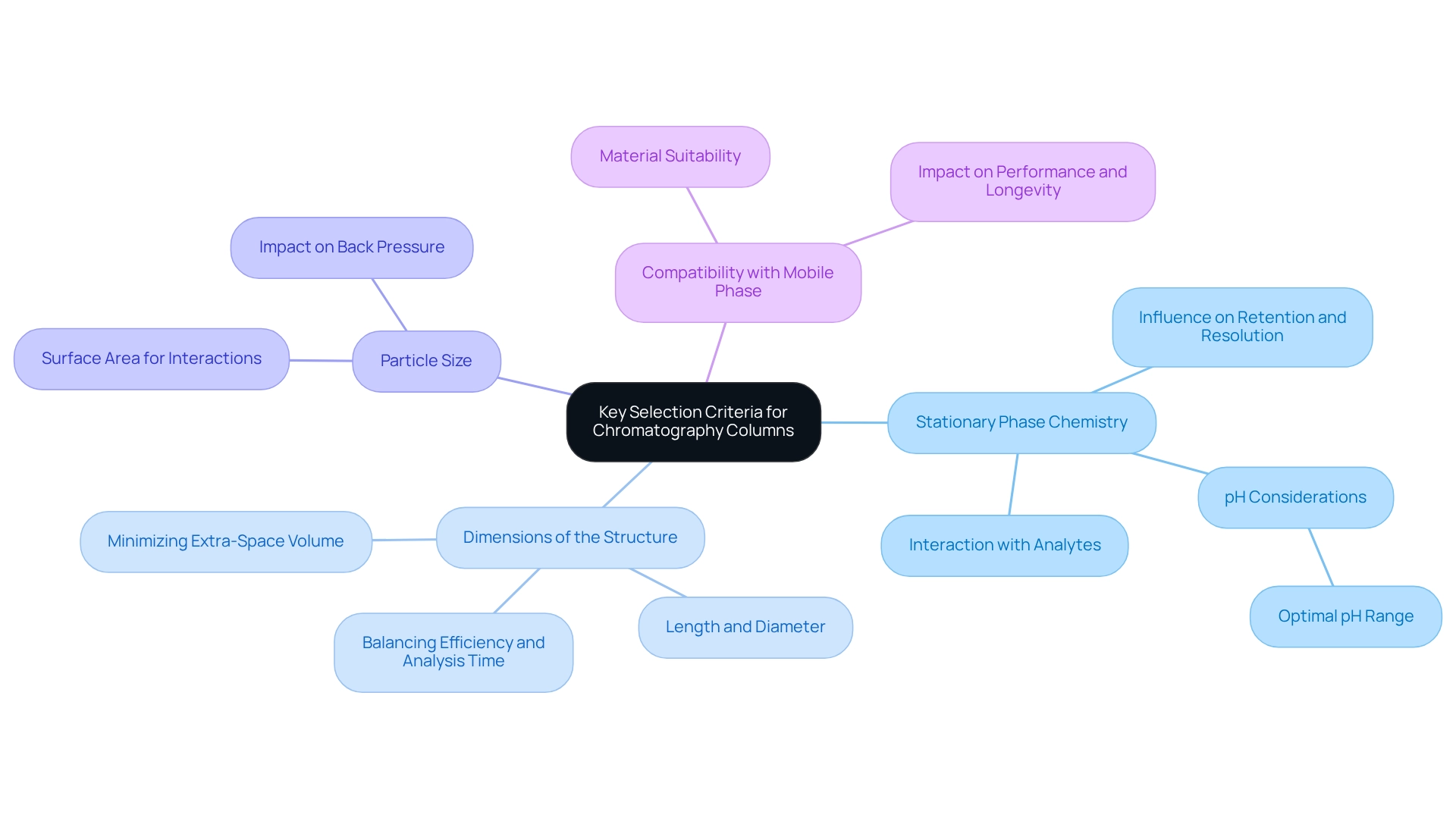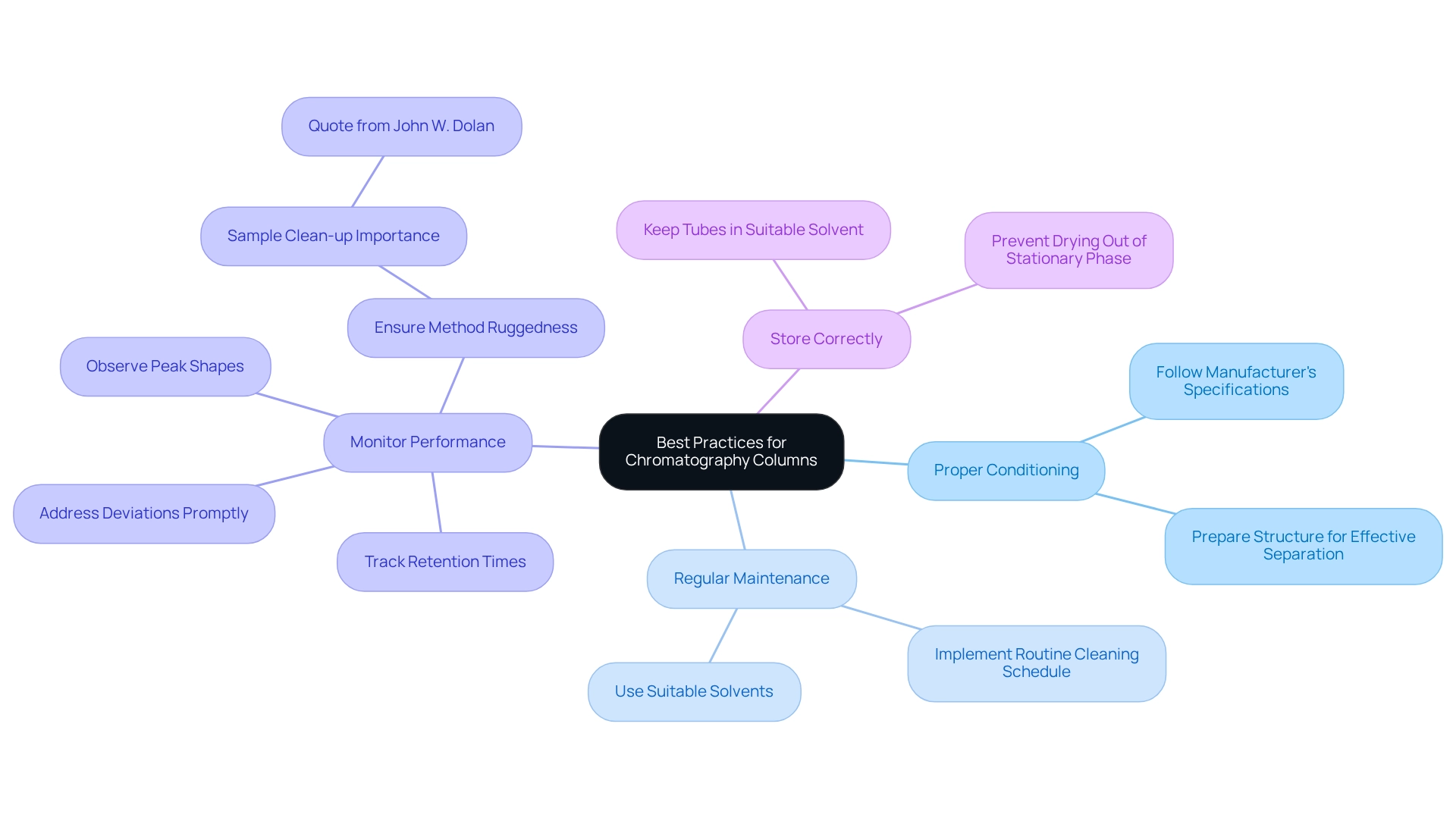Overview
The article presents critical steps for effectively selecting chromatography columns, highlighting the necessity of understanding various column types, key selection criteria, and best practices for optimal usage. It elaborates on the distinct functions of different column types, such as normal phase and reverse phase, while outlining essential factors like stationary phase chemistry and maintenance practices. These elements are crucial for enhancing analytical performance and reliability in laboratory settings, ultimately reinforcing the importance of high-quality scientific instruments.
Introduction
In the realm of analytical chemistry, chromatography emerges as a pivotal technique, empowering scientists to separate and analyze complex mixtures with unparalleled precision. By leveraging the unique interactions between stationary and mobile phases, researchers can effectively unravel the components of various substances, encompassing pharmaceuticals and natural products alike.
As advancements in chromatography technologies continue to progress, a comprehensive understanding of the fundamental principles, types of columns, and best practices for their application becomes increasingly vital. This article delves into the essentials of chromatography, exploring its underlying mechanics, the diverse range of column types available, and the critical criteria for selecting the appropriate column to optimize analytical performance.
With a focus on enhancing reliability and efficiency, it underscores the importance of proper column maintenance and the role of innovative technologies in shaping the future landscape of chromatography.
Understand Chromatography Basics
Chromatography serves as a fundamental method for separating components of a mixture, leveraging their unique interactions with both a stationary medium and a moving medium. This process involves passing a mixture through a structure filled with a stationary phase, where various components migrate at differing rates, ultimately leading to their separation. Understanding key concepts is critical:
- Stationary Phase: The material within the column that interacts with the sample, playing a pivotal role in the separation process.
- Mobile Phase: The solvent that transports the sample through the tube, influencing the movement and separation of components.
- Retention Time: The duration required for a specific component to traverse the structure, which is vital for identifying and quantifying substances.
A solid grasp of these principles is essential for selecting the appropriate separation medium, as they directly impact the efficiency and resolution of the analysis. JM Science Inc. offers a variety of high-quality HPLC columns and accessories, including Shodex and CapcellPak columns, designed to enhance the efficiency of analysis systems. Recent advancements in separation techniques have markedly improved the precision and reliability of data, particularly in the analysis of complex mixtures, such as herbal components. For example, innovations in liquid chromatography-mass spectrometry (LC-MS) have significantly advanced the identification and quantification of natural drug molecules, establishing it as a cornerstone in pharmaceutical sciences. A recent study underscores how these innovations in LC-MS have propelled the analysis of natural drug molecules, highlighting their significance in pharmaceutical applications.
Moreover, the enforcement of stringent safety regulations in the food and pharmaceutical industries is expected to drive growth in separation systems, underscoring the increasing importance of these methods in laboratory settings. As noted by senior analyst Komal Dighe, "Advancements in separation software and systems and enforcement of strict food and pharmaceutical safety regulations will likely create new growth opportunities for separation system manufacturers." Understanding the interaction between stationary and mobile phases is crucial, as it directly affects the efficiency of separation processes, ultimately leading to more accurate and comprehensive evaluation outcomes. Additionally, the cost of equipment for HPLC is significantly higher than that of traditional HPLC systems, highlighting the investment necessary for effective chromatography solutions.
Explore Different Types of Chromatography Columns
Chromatography columns are indispensable instruments in analytical chemistry, each meticulously crafted for distinct applications based on their unique properties. The main varieties encompass:
- Normal Phase Supports: These supports utilize a polar stationary medium in conjunction with a non-polar mobile medium, making them particularly adept at isolating polar compounds. They are frequently employed in processes such as the purification of natural substances and the analysis of complex mixtures.
- Reverse Phase Structures: Characterized by a non-polar stationary phase paired with a polar mobile phase, reverse phase structures are widely utilized for non-polar analytes. Their versatility and efficiency in separating a broad spectrum of compounds make them the preferred choice in pharmaceutical applications, particularly for analyzing small molecules and peptides.
- Ion Exchange Structures: These structures facilitate the separation of ions based on their charge, rendering them essential for purifying biomolecules like proteins and nucleic acids. They find extensive application in biopharmaceutical development and quality assurance processes.
- Size Exclusion Devices: Designed to separate molecules by size, these devices are commonly used in protein purification and the analysis of polymers. Chromatography columns enable the effective separation of large biomolecules from smaller impurities, ensuring high purity standards, and the choice of chromatography columns significantly impacts both the effectiveness of separation and the quality of measurement outcomes.
With the market for separation devices projected to reach USD 14.1 billion in North America by 2037, understanding the unique applications and advantages of each type is crucial for enhancing laboratory processes and achieving precise results. Furthermore, according to data from the Congressional Budget Office of the U.S., the total R&D expenditures of the pharmaceutical sector amounted to USD 83 billion in 2019, underscoring the critical investment in research that highlights the importance of reliable testing instruments such as separation devices. Key players in the separation media market, including Merck KGaA, Thermo Fisher Scientific, and Waters, drive innovation and advancements in purification technologies, further emphasizing the necessity for pharmaceutical lab managers to stay informed about the competitive landscape.
Evaluate Key Selection Criteria for Columns
Selecting the right chromatography columns is crucial for achieving optimal analytical performance. The key criteria to consider include:
- Stationary Phase Chemistry: The choice of stationary phase is vital, as it must interact effectively with your analytes to ensure optimal separation. The chemistry of the stationary layer significantly influences the retention and resolution of compounds, especially in complex mixtures. As Tom Elich, Manager of MSAT Purification Process Engineering at MilliporeSigma, observes, "One example is a monoclonal antibody with an isoelectric point of 8; the mobile phase must be less than pH 8 but higher than pH 6 to maximize binding, so having the right pH in your mobile phase is key."
- Dimensions of the Structure: The length and diameter of the structure play a pivotal role in determining resolution and analysis time. Longer sections typically enhance separation efficiency but also extend analysis duration. Balancing these factors based on your specific application needs is essential. Additionally, minimizing system extra-space volume can enhance efficiency (N), making it a critical factor in your selection of columns.
- Particle Size: Smaller particle sizes increase the surface area available for interactions, leading to improved resolution. However, this can also result in higher back pressure, necessitating adjustments in your system setup.
- Compatibility with Mobile Phase: Ensure that the material is suitable for the solvents you plan to utilize. Incompatibility can lead to degradation of the structure, adversely affecting both performance and longevity.
By considering elements like stationary phase chemistry, particle size, dimensions of the tube, compatibility, sample characteristics, and specific application requirements, you can enhance your HPLC method development and performance with chromatography columns. A thorough assessment of these factors allows you to choose a separation device that aligns with your analytical goals, ultimately improving the dependability and effectiveness of your results. The importance of resolution in HPLC is underscored by the case study titled "Resolution Considerations in HPLC," which discusses the risks of co-elution when operating close to the solvent front, emphasizing the need for careful method development.

Implement Best Practices for Column Usage
To ensure optimal performance and longevity of your chromatography columns, it is essential to adhere to the following best practices:
- Proper Conditioning: Always condition new columns according to the manufacturer's specifications. This crucial initial step prepares the structure for effective separation and can significantly impact performance.
- Regular Maintenance: Implement a routine cleaning schedule to remove contaminants and prevent blockages. Utilize solvents that are suitable for the stationary medium to preserve integrity and performance.
- Monitor Performance: Regularly track retention times and peak shapes. Any deviations may signal the need for maintenance or replacement, ensuring that you collect meaningful data from your samples. As John W. Dolan, Editor of 'LC Troubleshooting', emphasizes, "Sample clean-up should be to improve method ruggedness so that you are assured of collecting meaningful data from your samples."
- Store Correctly: When not in use, keep the tubes in a suitable solvent to avoid drying out and harming the stationary phase. Proper storage is essential for maintaining the functionality of the structure over time.
Incorporating these practices not only maximizes the efficiency of chromatography columns but also extends their lifespan. For instance, a case study on electronic solutions for HPLC performance tracking highlights how modern chromatography software can automatically monitor key performance metrics, providing real-time alerts for potential degradation. This proactive approach to maintenance ensures dependable workflows and enhances method robustness, ultimately leading to more precise results. Additionally, while SPE cartridges or 96-well plates can cost at least $2 per sample—twice the cost of an analytical column—proper column maintenance can significantly reduce overall costs by extending the life of your analytical columns. By following these guidelines, you can enhance the reliability and effectiveness of your chromatography columns. For further assistance, consider directing questions to the online Chromatography Forum.

Conclusion
Understanding the fundamentals of chromatography is essential for anyone involved in analytical chemistry. This technique, which utilizes the interactions between stationary and mobile phases, is pivotal for separating and analyzing complex mixtures. Grasping basic concepts such as stationary phase chemistry, mobile phase selection, and retention time is crucial, as these factors directly influence the efficiency and accuracy of analytical results.
Exploring the various types of chromatography columns reveals their unique applications and advantages. Normal phase, reverse phase, ion exchange, and size exclusion columns each serve distinct purposes in laboratory settings, highlighting the necessity of selecting the appropriate column type to achieve optimal separation outcomes. As the market for chromatography columns continues to grow, understanding these options becomes increasingly critical for researchers and laboratory managers alike.
Selecting the right chromatography column requires careful consideration of several key criteria, including stationary phase chemistry, column dimensions, and compatibility with mobile phases. By thoroughly evaluating these factors, analysts can enhance their method development processes and ensure reliable results. Best practices for column usage are also underscored, emphasizing the importance of proper conditioning, maintenance, and monitoring to extend the lifespan and effectiveness of chromatography systems.
Ultimately, as advancements in chromatography technologies and stringent safety regulations shape the future of analytical chemistry, staying informed about these developments will empower researchers to optimize their workflows. By embracing the principles, types, and best practices outlined, professionals can enhance the reliability and efficiency of their chromatography applications, paving the way for continued innovation in the field.




